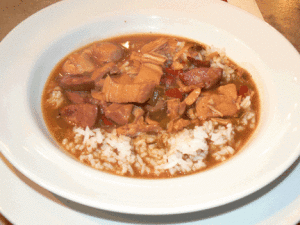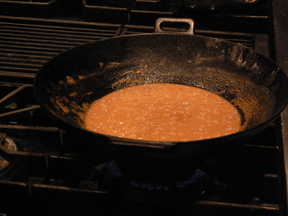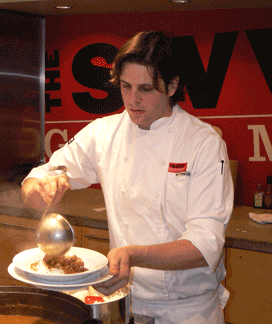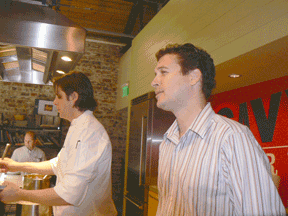text and photos © 2008
You’ll hear a lot about Cajun and Creole culture in Louisiana. They’re proud of their traditions and unique character, but for an outsider it’s hard to get a grasp on who and what is one or the other. Creole refers to any descendant of those living in French Louisiana before it became an American territory. As a people Creoles derive from the intermingling of French, Spanish, Caribbean, African and native American populations. Cajuns are descendents of French Acadians, who were exiled from Canada by the British in 1755 and came down the Mississippi to settle Southern Louisiana.
In the broad picture, Creoles are more associated with New Orleans, while Cajuns kept to the country to the west and north of the city. In reality, Creoles and Cajuns have always lived side-by-side. So there is a blending of Cajun and Creole cultures and in the area of cuisine, where one leaves off and the other begins is open to interpretation. Most hold that Creole cooking is lighter, creamier, less spicy and more refined, and uses more tomatoes, while Cajun food is regarded as more flavorful, spicy and rustic, and uses more greens (collard greens, mustard greens, turnip greens). For the curious visitor, it’s not so clear-cut.
Trying to get a clear answer is not easy. Matt Brewton, a Cajun chef and cooking instructor at The Savvy Gourmet in New Orleans, explains why. “The trouble with talking to chefs is you take 10 different chefs from the exact same neighborhood, with the exact same dish, and we’ll do it 10 different ways and tell you 10 different stories behind it. Depends how your grandpa did it, how your neighbors do it. When I make gumbo, I like it thick and rich, but a lot of chefs around here make it brothy. I had a friend who used to put a whole egg in the shell into his gumbo when he was cooking it. As soon as you take that egg out and peel the shell off it, you’ve got a brown egg that tastes just like gumbo. I’ll bet you folks don’t know a lot of traditional Creole and Cajun people don’t use rice; they pour their gumbo over potato salad.”

The Real Deal Chicken and Sausage Gumbo from the Savvy Gourmet in New Orleans,
photo by Scott W. Clemens
So there you have it straight from the horse’s mouth. Now as Matt Brewton said (and Mama Redell (of Vermilionville Creole/Cajun Heritage Folk Park) reiterated, every chef has a different take on the correct way to make any Cajun or Creole dish. However, since both Brewton’s Real Deal Chicken & Sausage Gumbo and Crawfish Etoufée were the best of all those I tried over a week of diligent feasting throughout Cajun Country, Baton Rouge and New Orleans, I think it prudent to refrain from commenting and just let the man speak for himself. Pay attention, ‘cause class is in session:
“Our flavors are completely unhealthy for you — lots of pork fat, rich, deep, dark rouxs, lots of sausage — tons of great flavors. But the two things that connect the Cajuns and Creoles is their roux and the trinity. Any other style of cooking — Italian, Spanish, French — they have a mirepois, made of carrots, onions and celery. Cajun and Creole cooking have the trinity; the trinity is bell pepper, onions and celery. We can’t grow carrots down here, but we can grow bell peppers really well.
“The roux flavors, thickens and adds color. There are four different stages to the roux. There’s a blonde roux, a brown paper bag colored roux, a milk-chocolate roux, and a dark chocolate roux. What we use for the gumbo we’re cooking today is the dark chocolate roux. What that is, is flour and fat cooked so it starts to brown. As it changes color it changes flavor. Brown paper bag rouxs are used for crawfish étoufée, they’re used for turtle soups. Our dark chocolate roux is used for gumbo.
“Really traditional Cajun rouxs come from bacon drippings, but a lot of people nowadays use corn oil, canola oil, grape seed oil, or clarified butter. But you can’t use extra virgin olive oil (because it burns), and you can’t use regular butter because the milk solids in the butter burn. If you were to make a dark roux, which takes 35 to 40 minutes to get to that dark state, you’d burn that butter and it would make your whole gumbo taste burnt.
“Now my dad is a Native American-Cajun mix, just a crazy ol’ backwoods guy, and when he makes his roux he just grabs a Budweizer, pulls his chair up to the stove, turns it down to low and just stirs for hours and hours and hours, and that’s how most older Cajun people make their roux. If you’re in a hurry like I am you want to make it in ten or fifteen minutes, instead of an hour…an hour-fifteen minutes.
“It’s best to use a heavy bottomed pan when making a roux; I like to use cast-iron because it distributes the heat very evenly. If you’re making a roux in an aluminum or stainless steel pot, you’re more than likely going to burn that flour around the edges. For this batch, for 12 quarts of gumbo I used 3 cups of chocolate [colored] roux. Be careful stirring because it’s very hot; it’ll get up to 230 to 300 degrees just in the blonde stage. If a little piece jumps out of the pan and lands on your hand, that’s what chefs around here call Cajun napalm; don’t rub it off with your other hand, you’ll just burn your other hand. Blot if off with a towel.

“A blonde roux is great for gravy, vegetables, macaroni. The next stage is the brown paper bag colored roux. That’s good for étoufée. Most chefs in New Orleans will use a dark chocolate brown roux in their gumbo.
“Roux is kind of a funny thing. When you’re making roux it will start out liquidy. When it passes to the milk chocolate from the brown paper bag stage it will start to thicken until it looks like there’s no liquid in there. And when it gets to the chocolate brown stage it breaks down and gets liquidy again. What you want to look for, besides the consistency, is the smell of popcorn. For your gumbo you start your Trinity cooking with the sausage and then you add your roux when it’s at the milk chocolate stage, and you keep cooking it in one pot until it turns to the dark chocolate stage. When it looks like a melted Hershey bar you add your liquid. Then you simmer it two to three hours.
“What I like to do is if I’m making gumbo on Saturday, I make my roux on Thursday. When I’m done I take it off the heat and let it cool, and oil rises to the top slowly over the next day. Then I can just pour it off, and it saves me the time of having to strain it. If you refrigerate it, it will turn solid, just like a brick. If you don’t refrigerate it, it will probably last a good week sitting covered on your stove. I pour off all the oil; the oil is just there to lubricate the flour and keep it from burning. Now you never want to eat a roux raw; you want to mix it with water or stock.”
Wow, Matt Brewton can talk! — I couldn’t get a word in edgewise! And that, dear readers, is how to make a roux, which is the basis for gumbo, étoufée and jambalaya.
Just to be clear, according to Mama Redell, Creole gumbos often (but not always) use okra as a thickener, and Cajuns sometimes (but not always) use filé powder (powdered sassafras leaves) to adjust the thickness — and note that the filé should be added right at the end or it will clump.

Chef Matt Brewton ladling his gumbo at the Savvy Gourmet
The Savvy Gourmet, where Matt Brewton demonstrated the art of making a roux, is a cooking school / weekend restaurant / caterer / kitchen design / kitchen supply store on Magazine Street on the west side of New Orleans. The two owners of the store have to be two of the unluckiest individuals on the planet.
The Savvy Gourmet was founded as a cooking class in 2001 by psychologist Dr. Aaron Wolfson. It started in his kitchen with a few of his friends, and expanded over the next couple of years as guest chefs held evening classes at a few lunch-only restaurants.
In the meantime, Wolfson’s childhood friend, Peter Menge, was living in New York and working at The World Trade Center. When the Trade Center collapsed it destroyed Peter’s nearby apartment building, leaving him without a job or home, and with a sense of karmic doom.
In 2003 he moved back to New Orleans and joined Wolfson. The idea was to find a location where they could sell kitchen supplies in the front of the store and hold cooking classes for locals in the back. They leased an old building on Magazine Street and spent 18 months renovating it before opening in August of 2005, a week before Hurricane Katrina hit. Weeks later when they were able to return, they found they were lucky in one way — the building had been spared the flood. But the air was thick with rotten food, and their clientele had left the city.
While they were cleaning the place up, Hurricane Rita hit, and Peter Menge lost his St. Charles home. His sense of doom must now have been complete.
As for clientele, what flood-ravaged victim of two hurricanes wouldn’t be interested in filling their leisure time with a cooking class? — (I can hear the screams from here!) Much of the city was still without power, and people were subsisting on sandwiches in bars. So Wolfson and Menge adapted their business model and put in some tables and chairs, wi-fi internet and cable TV and began serving lunch to relief workers and returning locals. That move saved the business.
 |
|
Matt Brewton and Peter Menge
|
Today they’re back to their original business model — a cookware store up-front, cooking classes in the back, plus a catering business, gourmet-to-go food Tuesday through Friday, and brunch on Saturday and Sunday. So maybe this is a story of “All’s well that ends well” after all.
If you’d like to take one of their cooking classes, check out their schedule online at www.savvygourmet.com. Special classes can be arranged to meet your requirements. The store is located at 4519 Magazine Street between Jena and Cadiz. Telephone: 504-895-2665.
